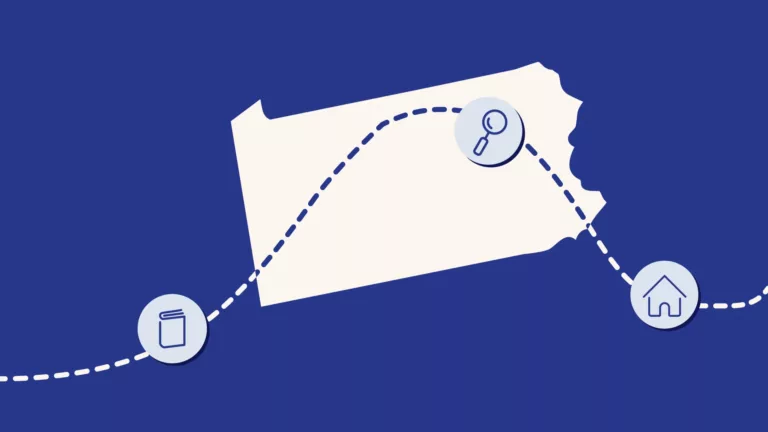The first time you buy a home, you’ll probably run across a fair number of mortgage-industry terms that you haven’t encountered before. If you find yourself stumbling a bit on terms you don’t know or acronyms you don’t understand, you’re not alone. Mortgage acronyms can stymy even the most financially-savvy potential homebuyers.
We’ve put together this handy guide to explain some of the most common (and most-commonly misunderstood) mortgage acronyms. Want to know what DTI is, and how it affects your home buying plans? Not sure what the difference is between an APR and an interest rate? We’ve got you covered, and for quick definitions of common mortgage terms, checkout out our Mortgage Glossary.
APR: Annual Percentage Rate

You may recognize this acronym from your credit card statements. APR (that’s annual percentage rate) is a reflection of the cost of borrowing money—in this case, borrowing money for your mortgage.
Fun fact: the APR on your mortgage is not exactly the same as your mortgage interest rate. In addition to the interest rate, the APR on your mortgage includes other, additional costs of borrowing, like fees or points or closing costs.
If you are trying to compare two mortgages side-by-side with different fee structures, be sure you compare both interest rates and APRs. A lower interest rate but a higher APR usually means more fees.
Related: Differences between APR and interest rate when evaluating mortgages
ARM: Adjustable Rate Mortgage

Unlike most of the mortgage acronyms on this list, ARM (that stands for adjustable rate mortgage) is usually pronounced like the limb, not A-R-M.
As the name suggests, the interest rate on an ARM adjusts periodically, usually based on a market index. Most ARMs have a set timeframe during which the initial interest rate remains steady. After that, interest adjusts periodically for the remainder of the loan term. Because the interest rate on an ARM can go up or down, the monthly payment amount for the mortgage may go up and down as well.
ARMs allow lenders to collect higher interest rates in the future if overall interest rates go up. Lenders don’t worry about missing out on future higher interest rates with ARMs the way they do with fixed-rate mortgages. And for that reason, most ARMs have lower initial interest rates than comparable fixed-rate mortgages.
For buyers who only intend to stay in their homes for a few years, or who can afford higher future mortgage payments if it comes down to it, ARMs can be a good deal. You don’t like the idea of change or uncertainty when it comes to your mortgage bill? Then an ARM is probably not the way to go.
DTI: Debt-to-Income Ratio

DTI, or debt-to-income ratio, is an important mortgage acronym to understand because DTI is a major factor in determining mortgage eligibility.
The DTI calculation is actually pretty straightforward. Lenders look at how much of a borrower’s monthly income is needed to meet the borrower’s monthly debt obligations.
So, let’s say you make $5,000 a month. And let’s also say you pay $500 a month on your student loans, $200 each month for a car payment, and $300 per month on your credit cards.
$500 + $300 + $200 = $1,000
$1,000 in monthly debt obligations / $5,000 in mostly income = a 20% debt-to-income ratio (DTI).
For lenders, a lower DTI is better than a high one. The more of your income you’re spending paying off debts, the less income you have to spend on other necessities. And that means there’s a higher likelihood that you’ll default on a debt in the future. Generally, borrowers will need a DTI of less than 43% after the cost of their future mortgage is factored in to qualify for a mortgage.
So, in this example case, our borrower making $5,000 a month with $1,000 a month in other debt obligations could potentially qualify for a mortgage with a monthly payment of $1,150 or less. If she pays off the car loan and her credit cards, she would reduce her existing DTI to 10%. Then, she could potentially qualify for a mortgage with a monthly payment of $1,650 or less.
People with existing debts qualify for mortgages all the time. But reducing your debt load before applying for a mortgage increases the chances that you’ll be approved for a mortgage large enough to purchase the home you want.
LTV: Loan-to-Value Ratio

LTV, or the loan-to-value ratio, is a calculation that reflects the difference between the appraised value of your home and the amount of money you are borrowing from your lender to purchase the home.
Let’s say a seller accepts your offer on a home for $400,000. Then, the appraiser comes back with an assessment that says the home is worth $415,000. (Lucky you!)
You have $40,000 for a down payment. To buy the home, you’ll need to borrow $360,000 from the lender.
$360,000 / $415,000 (the appraised value, not the amount you are paying to the seller) = 86.75% LTV
Lenders calculate LTV for a few reasons. To start, lenders don’t want to lend people more money to buy a home than that home is actually worth. If a lender loans you a million dollars for home that’s only worth half a million, and you default, there’s no way the lender could come anywhere near recouping their loss through the usual foreclose-and-resell-the-home method. Lenders calculate LTV to make sure they’ve covered their tails, so to speak, if something bad happens and you default.
Lenders also prefer borrowers with more equity in their homes. If the LTV on your mortgage is higher than 80%, then the lender will most likely require you to pay PMI until you’ve built more equity in your home. (PMI! Another fun acronym! More on PMI below.)
Appraisals that come in lower than the agreed-upon selling price can be a bit of a headache for buyers because a low appraisal can upend the LTV calculation for the home. Sometimes, sellers will agree to lower their asking price to get the LTV down for a potential buyer. Or, a buyer can choose to put in a larger down payment to lower the LTV.
PMI: Private Mortgage Insurance

Most lenders require buyers who put less than 20% down to pay PMI, which stands for private mortgage insurance. You might see this expense referred to as MI (for mortgage insurance) or MIP (that’s mortgage insurance premium): the same concept. PMI is insurance that protects your lender in the event that you default on your mortgage.
Getting 20% of the cost of a home together for a down payment is tough, especially for first-time homebuyers. So PMI is a fact of life for many homeowners. The good news is that many mortgage borrowers only have to pay PMI for the first few years of owning their home. Once a borrower has reached the 20% equity threshold, the PMI requirement goes away. (The big exception: Federal-Housing-Administration-backed mortgages require mortgage insurance for the duration of the loan term. Even after borrowers have significant equity. So PMI should be a serious consideration if you’re thinking about an FHA loan.)
PITI: Principal, Interest, Taxes, and Insurance

Your monthly mortgage bill covers more than just repayment of the amount you borrowed to purchase your home. PITI is an acronym that stands for Principal, Interest, Taxes, and Insurance. Added together, PITI is essentially what-the-mortgage-bill-will-look-like-each-month.
Sometimes would-be-buyers forget to factor in taxes and insurance when estimating the monthly cost of their future mortgage. If you’re hoping to take out a mortgage that’s on the upper end of what you’re potentially eligible to borrow, make sure you’re remembering to consider the full monthly cost of your mortgage, and not just principal and interest.
Understanding just a few key mortgage acronyms can go a long way toward helping you feel more confident in your choices when it comes to your mortgage.
Do you have other mortgage questions? We’re here to help every step of the way.






